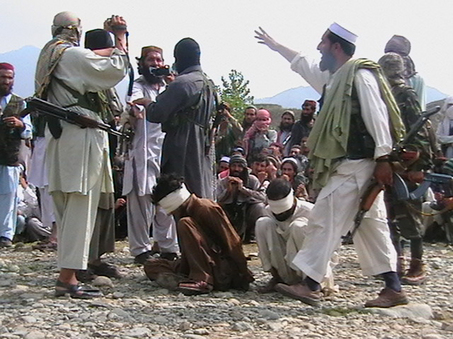Disturbing Pattern in Terrorist Violence in Pakistan
Two American experts have raised fresh doubts over the safety of Pakistan’s nuclear weapons. Their concern, interestingly, coincides with yet another certificate of safety issued by Obama administration this past week. And their conclusions appeared in an American magazine, Foreign Policy under an interesting title, ‘Jihadistan’.
Peter Bergen, who has co-authored the article along with policy analyst Katherine Tiedemann, is known as the author of ‘The Osama bin Laden I Know’. Both are working at the New America Foundation.

Their case is that jihadi violence has grown exponentially in Pakistan in recent years. It coincided with a drop in some popularity of al Qaeda and Taliban. Backed with graphics and maps, the analysis shows a pattern in terrorist strikes, which should be cause for worry to Islamabad and its patrons as well.
Because, in the past few months the Taliban have moved deep into Pakistan, at one point taking up positions just 60 miles from the capital, Islamabad. The Pakistani military is pushing back with aggressive military operations in the Swat Valley, which the government effectively ceded to Taliban control earlier this year.
With media barred from access to the frontline (there is only one instance of a conducted tour of ‘war zone’ by the army), it is difficult to verify the veracity of the claims Pakistan army regularly makes of its successes. The heightened militant strikes in Lahore and Peshawar tell their own story. Both the Army and the premier intelligence agency, ISI, are coming under attack regularly. In fact, they appear to have become very soft targets, if not sitting ducks in some instances to the militants they had nurtured with passion and zeal to achieve dubious short term goals.
No surprise, therefore, Bergen- Katherine analysis opens with the observation: ‘Pakistan is the headquarters of both al Qaeda and the Taliban, while Pakistani nuclear scientists have met with Osama bin Laden and proliferated nuclear technology to rogues states such as North Korea. Few countries in the world worry the Obama administration more….’.
Bergen- Katherine ask some very pertinent questions: ‘Just how stable is this nuclear-armed state? Where are Pakistan’s nukes, and how large is the country’s nuclear program? Just how strong are Pakistan’s militants? And how has the United States or the Pakistani state dealt with them either through military action or peace agreements?’ To these and many related questions they try to provide answers with a wide range of graphics and maps. And the message that emerges will not please Islamabad a wee bit.
NUCLEAR WEAPONS
As the violence rises in Pakistan, Americans are increasingly worried about the safety of Pakistan’s nuclear arsenal. The locations of Pakistan’s dozen or so nuclear facilities are largely a secret, but what is known is that one of the main nuclear research facilities is in Kahuta, outside Islamabad. This is where uranium is enriched via gas centrifuges. The district of Khushab, in Punjab province, is home to two plutonium production reactors, which may have eclipsed the uranium enrichment at Kahuta as Pakistan’s primary source of fissile material. And made Pakistan’s the fastest-growing nuclear weapons program in the world.
JIHADI TERROR
Jihadi violence has grown exponentially in Pakistan over the last several years. Insurgent attacks have increased more than 700 percent since 2005, and suicide attacks have increased 20-fold. Suicide bombers managed, for instance, to strike in three places in Pakistan in just one 24-hour period in April last year. And this April in just twelve hour period, the Pakistan Taliban carried out suicide bomb blasts at Peshawar and another place some 60 miles from there NWFP. The point is trend is clear: From only six suicide attacks in Pakistan in 2004 to 63 in 2008, terrorist violence has risen alarmingly.
PREDATOR STRIKES
As Bergen- Katherine point out, Obama had authorized a near-simultaneous pair of drone strikes against targets in North and South Waziristan just three days into his presidency.
Between when he took office and August 7, 2009, there have been 28 strikes, roughly one per week. Analysis of these strikes shows that the drones have killed some 350 people, with the August 5 attack killing Pakistani Taliban leader Baitullah Mehsud. Only one other strike has killed another important al Qaeda or Taliban leader, presumably because many of them have decamped from the tribal areas following the 34 drone attacks there in 2008, which killed at least 10 militant leaders.
Is the drone programme effective? This question arises as the Obama administration has decided in principle to concede the Pakistan army request for drone technology. If General Kayani is to read Bergen- Katherine verdict, he is bound to have second thoughts on drones. Because, the two American experts are unanimous that today the drone program seems to have hit the point of diminishing returns.
Bergen- Katherine contend that both Osama bin Laden and the Taliban have been losing some popularity in Pakistan since 2007. If that is indeed true then Pakistan Army should have gained an upper hand in containing militancy. It is not happening. In fact, the drop in Militant TRPs has coincided with the dramatic increase in terrorist attacks. Also the so called unpopularity of Osama-Taliban combine has not translated into more support for the United States.
‘Fewer than one in four Pakistani respondents have a favourable view of America. And when asked to name the principal threat to their security, more than half chose the United States, while only 8 percent said al Qaeda’, Bergen- Katherine write in their article on ‘Jihadistan’.
Article Source



